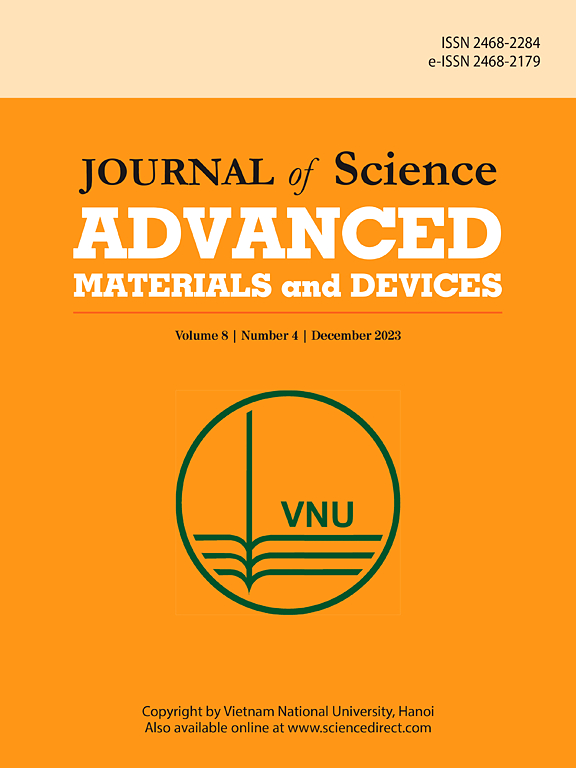基于mof -氧化石墨烯纳米复合物的血红蛋白基电极的制备及其对H2O2还原的电催化效果研究
IF 6.8
3区 材料科学
Q1 MATERIALS SCIENCE, MULTIDISCIPLINARY
Journal of Science: Advanced Materials and Devices
Pub Date : 2025-05-14
DOI:10.1016/j.jsamd.2025.100906
引用次数: 0
摘要
提出了氧化石墨烯与金属有机骨架材料的共混物作为生物大分子载体。采用常规滴铸法制备血红蛋白基电极,并将血红蛋白分子掺入纳米复合物中。氧化石墨烯上的含氧基团在纳米复合材料中元素之间相互作用中的作用,以及集成血红蛋白及其对酶参与电催化的影响,是当前手稿的主要目标。实验结果分析表明,氧化石墨烯上含氧基团的存在有助于改善与血红蛋白分子的纳米复合物的有序性,形成具有疏水外表面和亲水核的两亲胶束状结构。氧化石墨烯与金属-有机框架之间的相互作用会降低血红蛋白与金属-有机框架的结合强度,从而扭曲蛋白质分子内血红素位点的原始构型。金属有机骨架与含氧基团氧化石墨烯之间的多重相互作用产生协同效应,导致氧化石墨烯中电活性位点的电化学信号消失。纳米复合物中各元素之间的相互作用会抑制纳米复合物中氧化还原位点的电活性,而整合血红素蛋白可以在纳米复合物中发挥主要电活性物质的作用。氧化石墨烯表面含氧基团的存在可以通过血红素蛋白与氧化石墨烯的相互作用减缓电荷传输过程,从而抑制电催化效率。本文章由计算机程序翻译,如有差异,请以英文原文为准。

The preparation of hemoglobin based electrode on the basis of MOF-graphene oxide nano-complex and the investigation on its electro-catalytic effect on the reduction of H2O2
The co-mixture of graphene oxide and metal-organic framework material is proposed to act as a bio-macromolecule supporter. Hemoglobin based-electrode is prepared via the conventional drip-casting method, and heme protein molecules are incorporated into the nano-complex. The role of oxygen-containing groups on graphene oxide in the mutual interactions between elements within nano-composite, as well as the integrated hemoglobin and its impact on enzyme-involved electro-catalysis, are the primary objectives of the current manuscript. The analysis in the experimental results manifests that the existence of oxygen-containing groups onto GO would contribute to the improvement in the orderliness of nano-complex with hemoglobin molecule and the formation of an amphiphilic micelle-like structure with a hydrophobic outer surface and hydrophilic core. The mutual interaction between graphene oxide and a metal-organic framework would alleviate the binding strength of hemoglobin with metal-organic framework to distort the aboriginal configuration of the heme site within the protein molecule. The synergistic effect of multiple interactions between metal-organic framework and graphene oxide with oxygen-containing groups leads to the disappearance of the electrochemical signal for the electro-active sites in graphene oxide. The interaction between elements of nano-complex would depress the electro-activity of redox sites in nano-composite, and the integrated heme protein could play the role of the primary electro-active species in nano-complex with protein accommodation. The existence of oxygen-containing groups on graphene oxide could slow down the charge transportation process via the mutual interaction between heme protein and graphene oxide to restrain the electro-catalytic efficiency.
求助全文
通过发布文献求助,成功后即可免费获取论文全文。
去求助
来源期刊

Journal of Science: Advanced Materials and Devices
Materials Science-Electronic, Optical and Magnetic Materials
CiteScore
11.90
自引率
2.50%
发文量
88
审稿时长
47 days
期刊介绍:
In 1985, the Journal of Science was founded as a platform for publishing national and international research papers across various disciplines, including natural sciences, technology, social sciences, and humanities. Over the years, the journal has experienced remarkable growth in terms of quality, size, and scope. Today, it encompasses a diverse range of publications dedicated to academic research.
Considering the rapid expansion of materials science, we are pleased to introduce the Journal of Science: Advanced Materials and Devices. This new addition to our journal series offers researchers an exciting opportunity to publish their work on all aspects of materials science and technology within the esteemed Journal of Science.
With this development, we aim to revolutionize the way research in materials science is expressed and organized, further strengthening our commitment to promoting outstanding research across various scientific and technological fields.
 求助内容:
求助内容: 应助结果提醒方式:
应助结果提醒方式:


